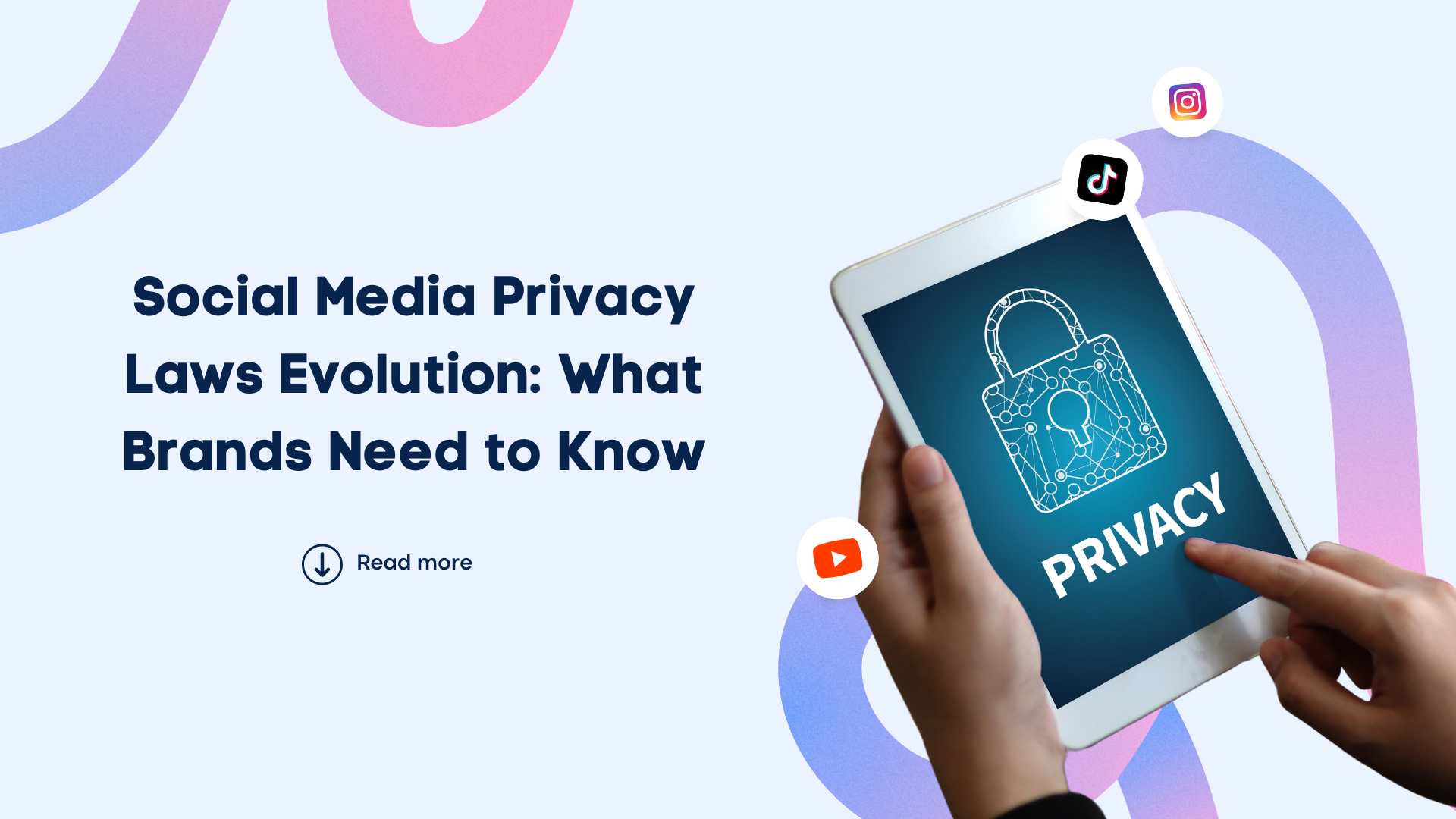Social media privacy laws are evolving at lightning speed, and as a social media manager, staying ahead of the curve is your superpower.
Navigating social media privacy laws is not a walk in the park.
It requires deep diving into the rules and regulations to ensure your clients’ brands, posts, ads, activities, and other social media interactions don’t land them in hot waters.
And with violations come potential sanctions—from demonetizations to account suspensions and bans.
The good news is that this guide can help by digging into the nitty-gritty of social media privacy laws so you don’t have to.
We’ll break down the must-knows and help you confidently breeze through compliance.
What you will learn
- What are social media privacy laws?
- Why social media privacy laws are essential
- Why brands need to understand social media privacy laws
- Types of social media privacy laws
- Social media privacy laws throughout history
- Common violations of social media privacy laws and regulations
- 9 Best practices to avoid social media privacy laws violations
- How to use Vista Social to ensure social media privacy laws compliance
- FAQs on social media privacy laws
- Understand the nuts and bolts of social media privacy laws
What are social media privacy laws?
Social media privacy laws are regulations designed to protect users’ personal data and privacy on social media platforms.
The laws dictate how companies collect, store, and use the personal information of their users.
It’s like a digital shield for the sensitive data that customers and users share when using social media platforms.
To stay updated with the constantly changing laws, brands must stay updated and ensure compliance to protect users while avoiding potentially hefty fines and maintaining brand trust.
Why social media privacy laws are essential
Social media privacy laws protect personal information from unauthorized use, access, and sharing by third parties and online platforms.
The laws help ensure that users control their data, keeping their privacy and security intact
Implementing data gathering and transparency standards prevents sensitive information misuse and reduces identity theft, cyberbullying, and other harmful activities.
Essentially, social media privacy laws aim to provide a safer and more responsible online environment.
Why brands need to understand social media privacy laws
Brands must understand social media privacy laws to protect their reputation, foster consumer trust, and avoid legal issues.
Compliance with these laws ensures that brands handle users’ personal information responsibly and transparently, fostering a positive relationship with audiences and customers.
Ignorance of these laws can lead to non-compliance, resulting in costly fines, potential lawsuits, and loss of consumer confidence.
Additionally, adhering to privacy regulations helps brands differentiate themselves as ethical and trustworthy, which can be a significant competitive advantage.
Ultimately, understanding and implementing social media privacy laws is essential for brands to operate ethically, sustainably, and successfully.
Types of social media privacy laws
The first step to understanding social media privacy laws is to know the various types, including the following.
Federal social media privacy laws
Several U.S. federal laws cover social media privacy concerns, such as:
- The Communications Decency Act (CDA) is a U.S. law that primarily aims to regulate indecency and obscenity on the internet, including protecting online platforms from liability for user-generated content under Section 230
- The Children’s Online Privacy Protection Act (COPPA) is a U.S. law that protects the privacy of children under 13 by requiring websites and online services to obtain parental consent before collecting, using, or disclosing personal information from children
- The Health Insurance Portability and Accountability Act (HIPAA) protects the privacy and security of health information shared on social media by healthcare providers and organizations
- The Federal Trade Commission Act (FTC Act) empowers the FTC to act on unfair or deceptive practices on social media platforms such as YouTube, Facebook, and Instagram
Other federal privacy laws are not specifically designed for social media but focus more on consumer protection within health insurance and financial institution contexts.
Must read: Fake Instagram Accounts: How to Block And Spot Them
Many of these laws aim to manage and protect consumer privacy from the risks that come with sophisticated data collection methods used by social media platforms.
There are no comprehensive national social media privacy laws in the U.S. yet.
State laws covering social media privacy
Several states are taking measures to amp up social media privacy protection.
California is known to have pioneered digital privacy legislation efforts in the U.S., which makes sense since the tech industry has a huge presence in the state (Silicon Valley).
Other states, such as Colorado, Virginia, and Texa,s are following suit and applying laws that include the following:
- Laws requiring companies to establish data security measures
- Laws that set criminal punishment and liability for hacking
- Laws requiring companies to notify users when data breaches take place
For instance, California requires businesses operating in the state to alert consumers of a data breach as quickly as possible.
Foreign data privacy laws covering social media privacy
The European Union has the General Data Protection Regulation (GDPR), which covers consumer data collection, storage, and more.
The GDPR has no U.S. equivalent, but it applies to any company that handles EU resident personal data, even if none of the parties are physically located in countries within the EU.
The GDPR does not protect U.S. residents directly, but since many companies on social media operate internationally, it covers consumers in the EU and U.S. markets.
The GDPR affects how your clients’ companies treat user data since it has become a modern standard for consumer privacy, including consumers on social media.
Additionally, ensure you understand each social media platform’s community guidelines since most are designed with state, federal, and applicable foreign laws and regulations.
Must read: WARNING! Instagram Community Guidelines You Shouldn’t Break
Social media privacy laws throughout history
The landscape of social media privacy laws has evolved significantly over the years to address the rapid growth and changing nature of digital communication.
Below is a brief look at the key milestones.
1990s: The Dawn of Internet Regulation
- 1996: Communications Decency Act (CDA): Enacted to regulate indecency and obscenity online. Section 230 became a cornerstone, providing immunity to online platforms for user-generated content
Late 1990s to Early 2000s: Protecting Children Online
- 1998: Children’s Online Privacy Protection Act (COPPA): Introduced to protect the privacy of children under 13 by requiring parental consent for data collection
- Early 2000s: Increased awareness of the need for online safety measures for children
Mid-2000s: Addressing Broader Privacy Concerns
- 2004: CAN-SPAM Act: Focused on reducing unsolicited commercial emails and requiring opt-out mechanisms
- 2006: FTC’s Online Privacy Reports: Reports highlighting the importance of online privacy and the need for industry self-regulation
Late 2000s to Early 2010s: Responding to Social Media’s Rise
- 2008: COPPA Amendment: Strengthening rules around children’s online privacy in response to evolving digital technologies
- 2011: FTC Privacy Framework: Establishing best practices for companies to protect consumer privacy online
2010s: Global Influence and Comprehensive Privacy Laws
- 2013: EU’s General Data Protection Regulation (GDPR): Introduced to give EU citizens more control over their personal data, influencing global privacy practices
- 2018: Implementation of GDPR: Enforcing strict guidelines on data protection and privacy for all individuals within the EU
2020s: Adapting to Emerging Technologies
- 2020: California Consumer Privacy Act (CCPA): Providing California residents with more control over their personal information and setting a precedent for U.S. state privacy laws
- 2022: Virginia Consumer Data Protection Act (VCDPA): Further expanding consumer privacy rights in the U.S.
As social media evolves, privacy laws will continue to adapt to new challenges and technologies.
That said, brands must stay informed and compliant to build trust and protect users’ data.
Common violations of social media privacy laws and regulations
Some of the most common violations against social media laws and regulations include the following.
- Collecting personal data without obtaining proper consent from users. This violation often involves platforms or services gathering personal information from users without clearly asking for their permission. This is especially problematic when involving minors, where laws such as COPPA require explicit parental consent before any data collection
- Not providing clear and transparent privacy policies. Your clients’ companies must communicate their data collection practices through privacy policies. The policies should detail what data is collected, how it is used, whom it is shared with, and how users can control their data. Failure to provide such transparency can lead to user distrust, reputation damage, or worse, legal issues
- Failing to safeguard personal information. Companies are responsible for protecting the data they collect from unauthorized access, breaches, or leaks. Inadequate security measures can lead to data breaches that expose users’ personal information
- Sharing or selling user data without explicit permission. User data should not be shared or sold to third parties without the user’s consent. This violates privacy regulations like GDPR and CCPA, which mandate user control over personal information
- Websites and services targeting children under 13 without verifiable parental consent. Under COPPA, online services targeting children under 13 must get verifiable parental consent before collecting personal information.
- Not informing users about data collection practices. Transparency is key in data collection. Users have the right to know what, how, and why their personal data is handled. A lack of transparency can lead to violation of regulations to the GDPR and CCPA, which require clear disclosures about data collection practices
- Not informing users of their rights to access, delete, or opt out of data collection. Users should be informed of their rights to access, correct, delete, or opt out of data collection. Not providing such information can lead to legal violations and user dissatisfaction
- Neglecting to implement adequate security measures. Companies must have robust security measures to protect user data from unauthorized access and breaches. Inadequate security can result in data leaks
- Engaging in deceptive practices or false advertising about data privacy and security measures. Companies must provide truthful advertising, especially regarding data privacy and security practices. Misleading claims can result in FTC guidelines violations, which can damage the credibility of your clients’ brands
- Improperly sharing protected health information on social media. Under HIPAA, healthcare providers and organizations must protect the privacy of health information. Sharing protected health information without authorization is a serious violation and can result in hefty fines and legal actions. Companies involved in healthcare software development must ensure their platforms are designed with HIPAA compliance and data protection in mind to avoid such violations.
- Failing to comply with user requests to access, correct, or delete their personal data. Privacy laws like GDPR mandate that users have the right to access, correct, or delete their personal information. Non-compliance can lead to significant penalties and damage to the company’s reputation
9 Best practices to avoid social media privacy laws violations
Check out the tried and true tips below to help you and your clients avoid violating social media privacy laws and regulations.
1. Conduct regular privacy audits
Regularly perform internal audits to assess the data collection and processing practices of your clients’ brands.
Ensure that your clients’ data handling complies with current and applicable privacy laws and identify areas that need improvement.
Conducting these reviews periodically helps you proactively maintain compliance and address potential issues before they escalate.
Another crucial approach is to engage third-party auditors to perform unbiased assessments of your clients’ privacy practices.
External audits can objectively evaluate and uncover compliance gaps that internal teams may overlook.
These audits can also demonstrate your clients’ commitment to transparency and accountability, enhancing their brands’ reputations.
2. Implement data anonymization techniques
Use data anonymization methods to strip collected datasets of personally identifiable information (PII).
Leverage techniques such as data masking, generalization, and suppression to help protect user privacy while allowing you to perform meaningful analytics.
The approach can reduce the risk of exposing sensitive information if unauthorized parties access the data.
Another effective data anonymization technique is to replace identifiable data with artificial identifiers or pseudonyms.
It helps ensure that the data remains useful for analysis but can’t be easily traced back to individual users.
Pseudonymization adds an extra layer of privacy protection and helps balance data utility with privacy requirements.
3. Foster a privacy centric culture
Perform regular training sessions to educate your clients’ employees about data privacy laws and their companies’ specific policies and procedures.
Ensure that everyone understands their role in protecting user data and the potential consequences of non-compliance.
Ongoing education helps keep privacy top of mind and reinforces the importance of safeguarding the personal information of your clients’ customers.
Consider designating team members as privacy champions who advocate for best practices and ensure department compliance.
The champions can serve as resources for colleagues, help identify privacy risks, and promote a culture of accountability and vigilance around data privacy.
4. Use privacy enhancing technologies
Encrypt all data (whether in transit or at rest) to protect it from unauthorized access.
Encryption ensures that intercepted or accessed without permission data remains unreadable and secure.
You can use strong encryption standards and keep encryption keys well-protected.
Also, deploy Multi-Factor Authorization (MFA) for accessing sensitive data and systems.
MFA adds a security layer by requiring users to provide multiple verification forms, such as passwords and fingerprints, before gaining access.
It can help prevent unauthorized access and strengthen overall data security.
5. Develop clear data handling guidelines
Create comprehensive documentation that outlines social media data collection, storage, processing, and sharing methods and processes.
The documentation should detail specific procedures for various data types and address unique sensitive information considerations.
Clear guidelines help maintain compliance across your clients’ companies, social media pages, and activities.
You can also establish Standard Operating Procedures (SOPs) for data handling and ensure all team members are familiar with them.
SOPs provide step-by-step instructions for common data-related tasks, helping to minimize errors and ensure that social media and overall privacy practices are consistently applied.
Regularly review and update SOPs to reflect changes in laws and your clients’ business practices.
6. Monitor social media activity
Implement reliable automated tools to track social media activity for potential privacy violations that lead to account bans and legal issues.
Must read: How to Get Unbanned on TikTok: Steps, Tips, FAQs [2024]
The tools can help identify and flag content that may breach privacy laws or your clients’ data policies, allowing you to take prompt corrective action.
You can also take things a step further by educating your clients’ audiences on protecting their privacy on social media.
For instance, you can create or share social media posts on tips and guidelines for configuring Facebook or Instagram privacy settings, avoiding oversharing, and recognizing potential privacy threats.
Must read: How to Temporarily Deactivate Instagram (Or Delete It): 2024
Empowering users to take control of their privacy can complement your clients’ compliance efforts and reduce potential violations.
7. Stay informed about regulatory changes
Subscribe to services that give updates on applicable social media and data privacy laws and regulations.
Staying informed about new and evolving legal requirements helps you ensure ongoing compliance and adjust your practices accordingly.
You can also join industry networks or associations that focus on data privacy.
Participating in these groups allows you to share knowledge, learn from peers, and stay updated on best practices.
Networking with other professionals can also help you gain valuable insights into how other brands handle social media and online privacy challenges.
8. Implement data minimization strategies
Collect only the data necessary for your clients’ specific purposes and avoid over-collection.
Data minimization reduces the personal information you need to protect and lowers the risk of non-compliance.
The key is to define the purpose of data collection and ensure that only relevant data is gathered.
Establishing data retention policies that specify data retention and deletion is vital.
Regularly purge outdated or unnecessary data to minimize storage risks and ensure compliance with legal retention requirements.
Effective data management helps prevent data overload and enhances your clients’ privacy protection efforts.
9. Utilize consent management platforms
Use consent management platforms to centralize and streamline obtaining and managing user consent.
These platforms help you track and document user consent preferences, ensuring a clear permissions record.
Also, allow users to provide granular consent for various data collection and use types.
Providing detailed consent options empowers users to control their data and enhances transparency.
Ensure specific, clear, and easy-to-understand consent requests.
How to use Vista Social to ensure social media privacy laws compliance
Maintaining compliant social media content and interactions across your clients’ pages and campaigns is no easy feat.
The good news is Vista Social can make things a whole lot easier for your team.
The social media management platform is packed with features that streamline planning, creating, reviewing, and publishing engaging posts that are above board.
Vista Social’s Publisher lets you upload, customize, and schedule posts in a few easy steps.
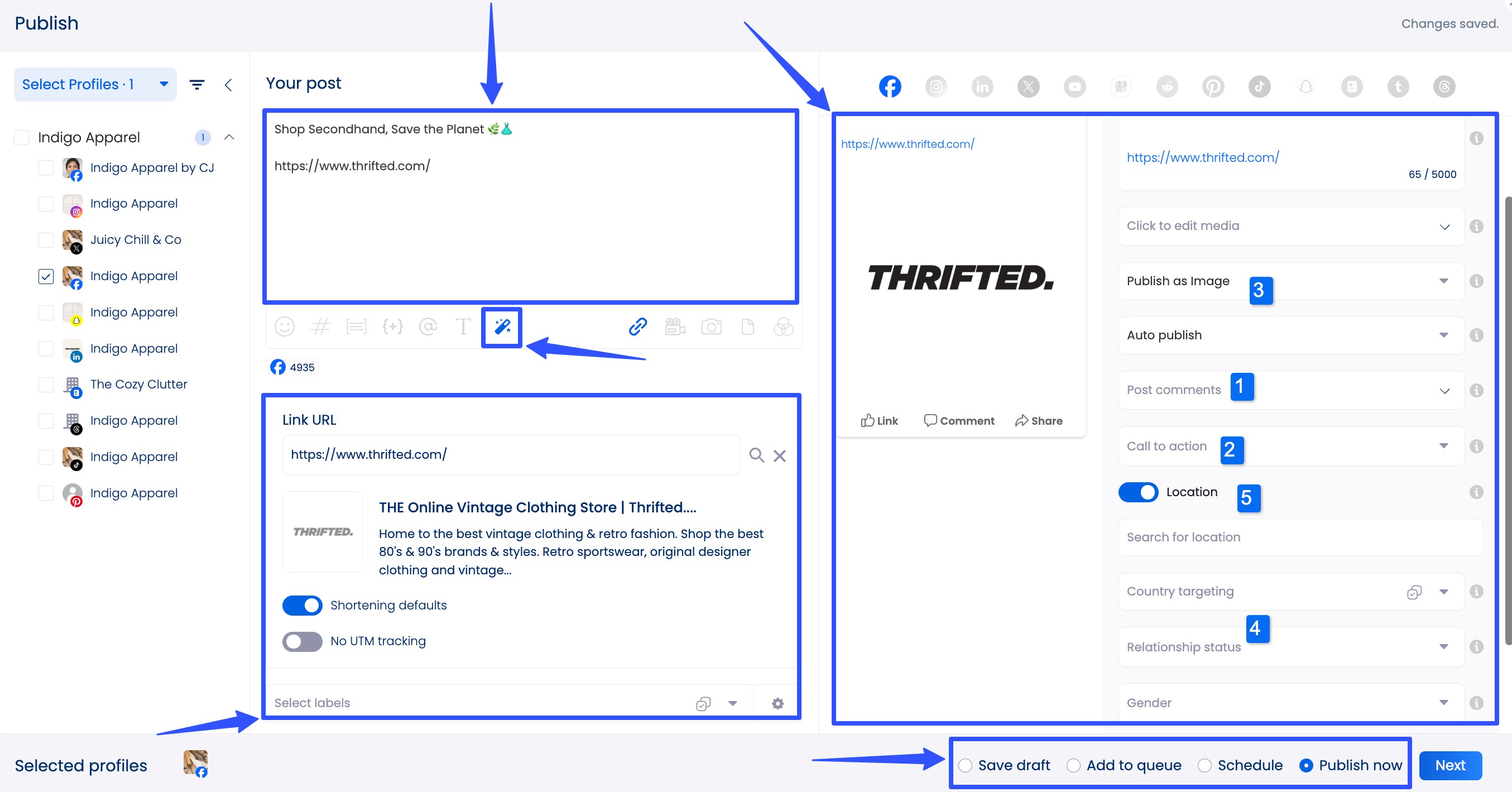
The feature includes a ChatGPT-powered AI Assistant that you can use to generate or refine your post captions quickly.
Once done, you can save your post as a draft for client review and approval to ensure legal compliance.
Must read: Facebook Draft Post: How to Save, Edit, And Manage [2025]
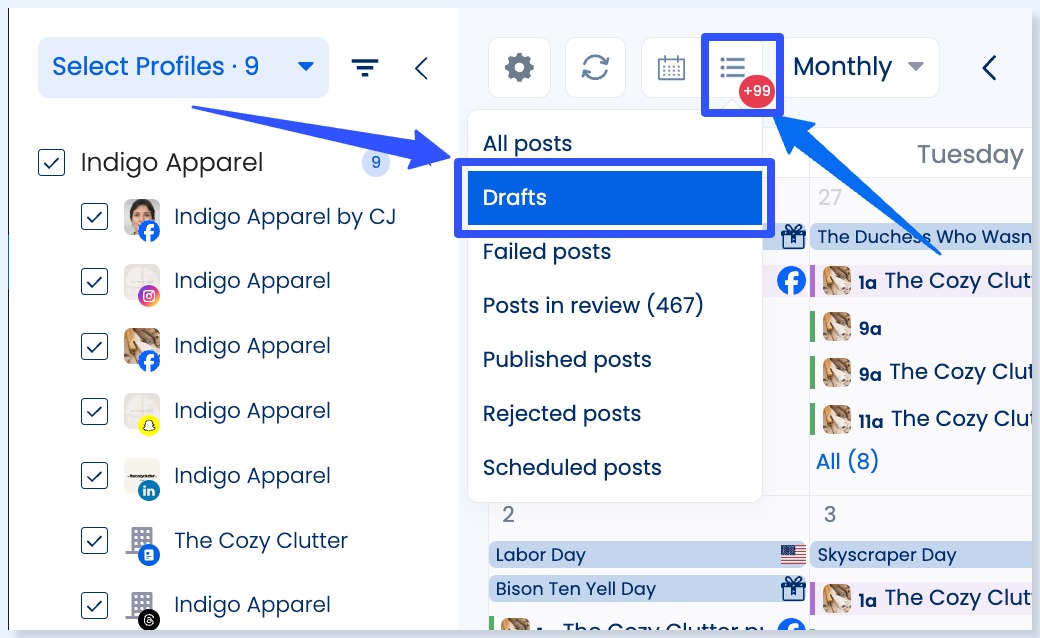
You can also add your post to a publishing queue, publish it immediately, or schedule it for auto-posting.
Must read: How to Automate Social Media Posts: w/ Tools & Tips
Set a specific time and date or choose from the platform’s optimal posting time suggestions.
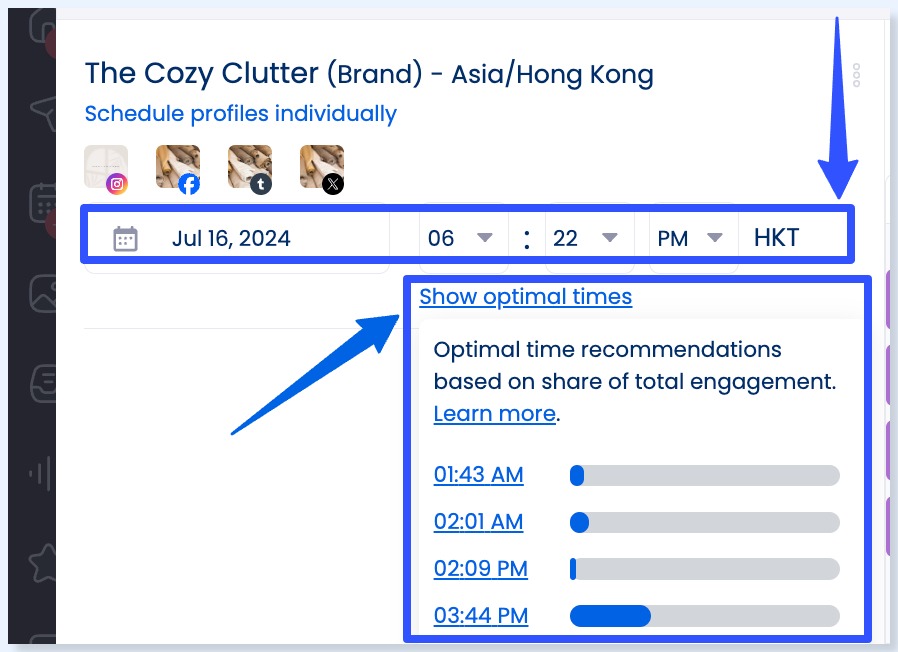
You can find and manage all your previously published, drafted, and scheduled posts on your Vista Social content calendar.
Must read: How to Create an Instagram Content Calendar: Quickly & Easily
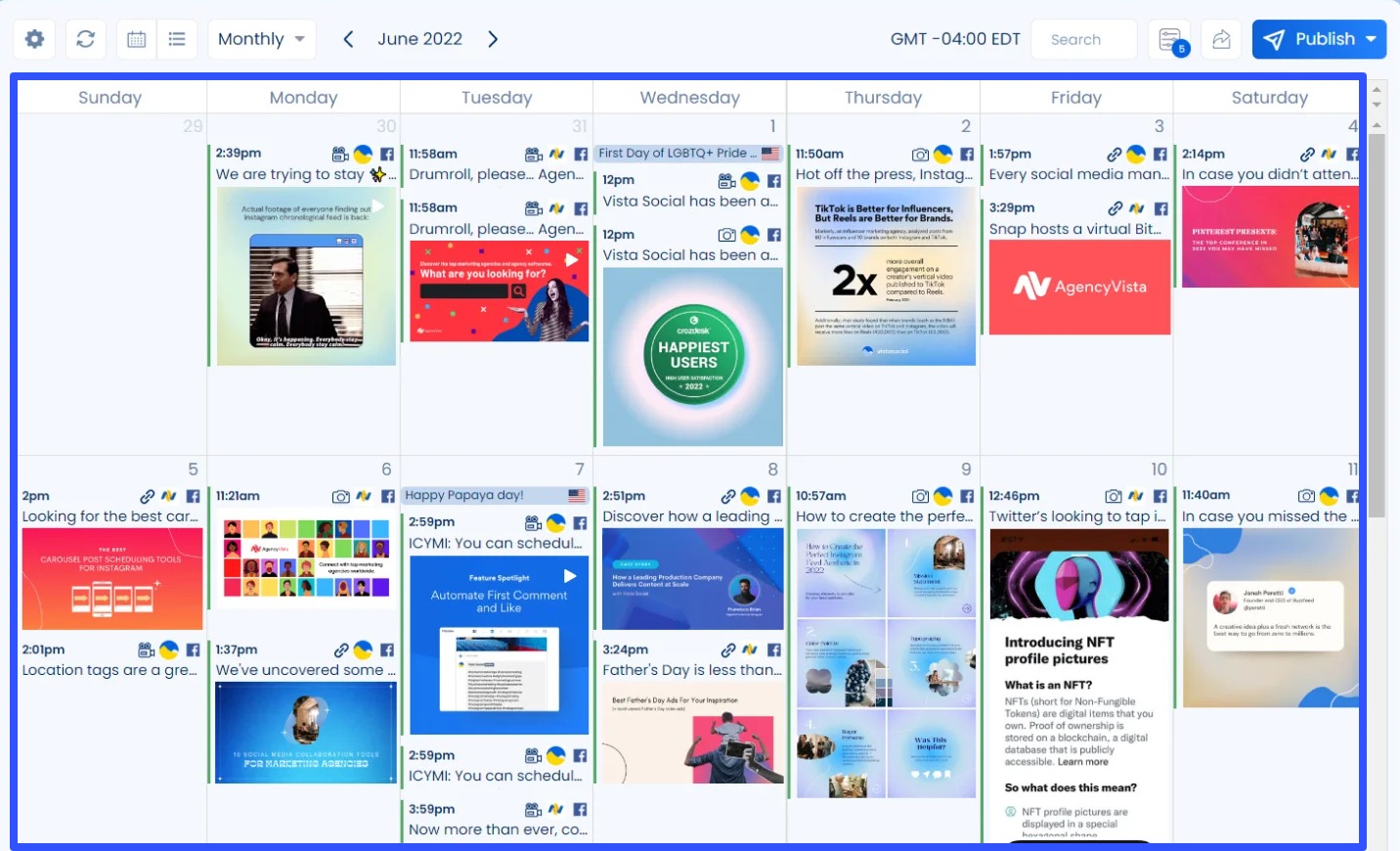
Users reviewing posts in your calendar can approve and reject posts and leave notes for revisions or explanations of why the post was rejected.
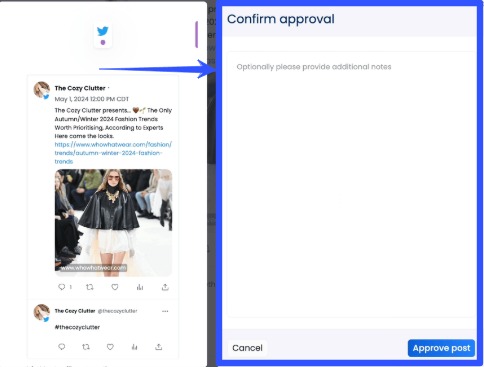
You can also set up automated post approval workflows to streamline your social media content review and approval process.
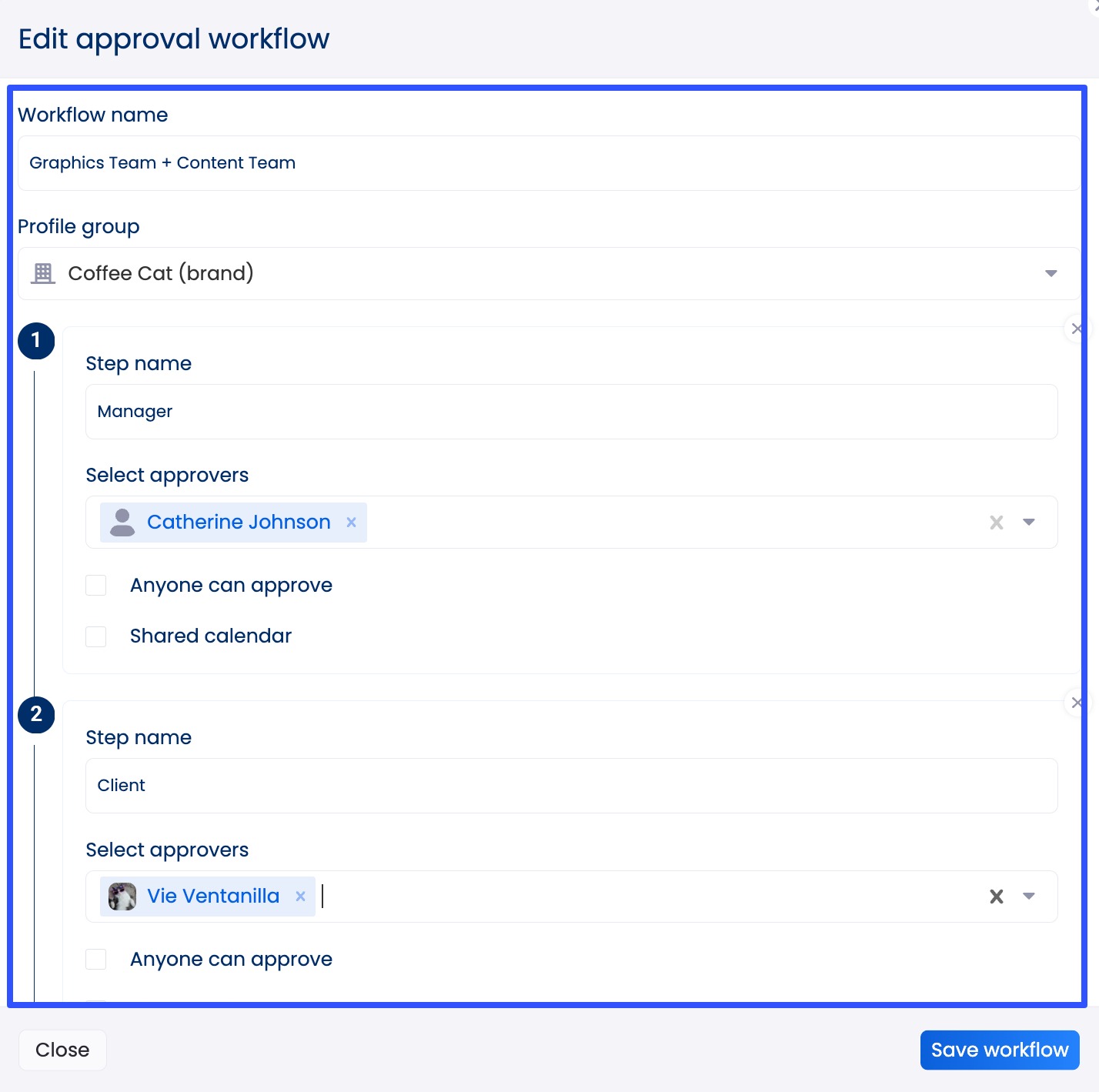
Vista Social offers a feature that allows you to create a brand safety and compliance policy for each client profile group.
You can create or paste your client’s current policy on the designated field or generate one using the platform’s AI Policy Generator.
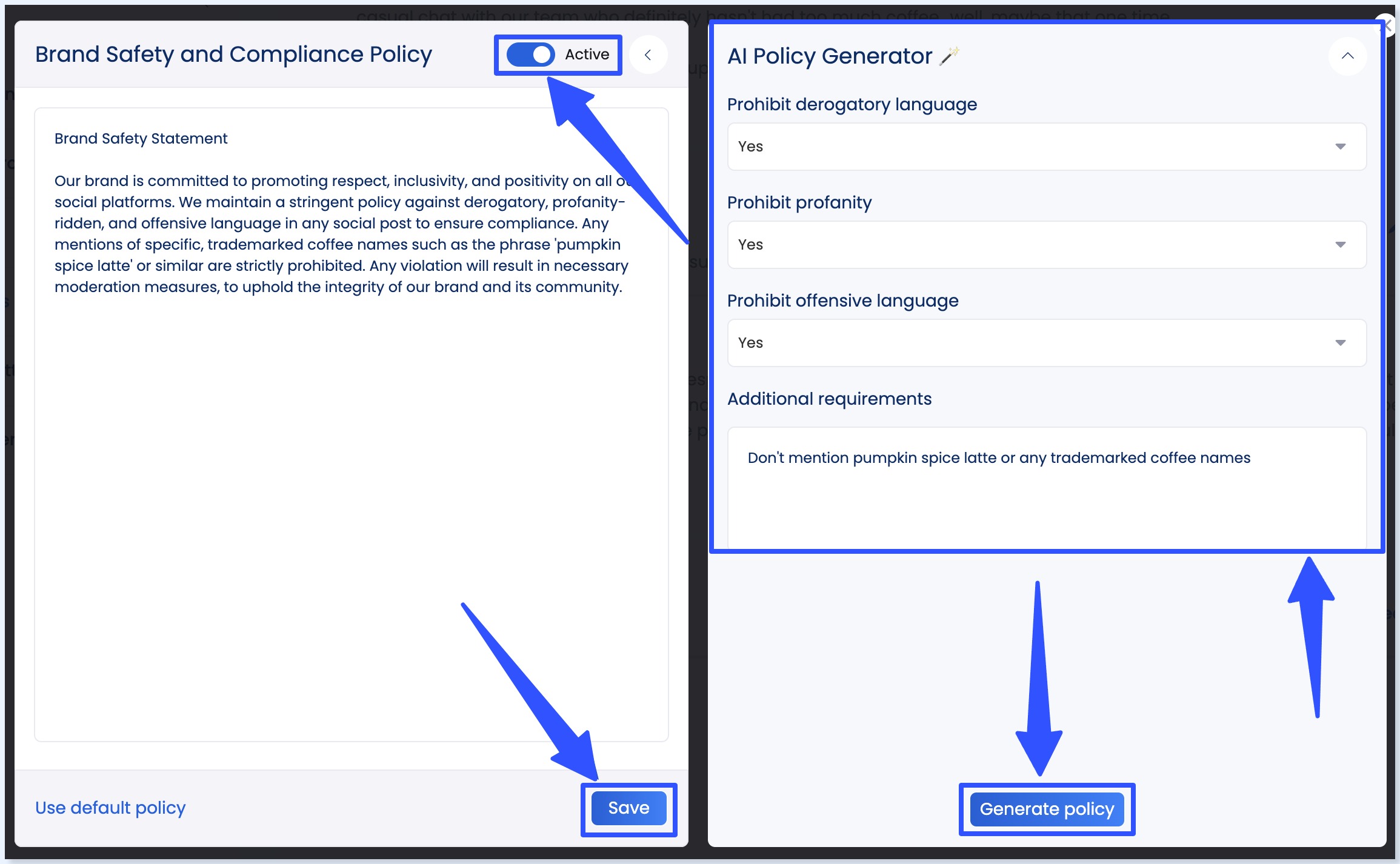
Team members will get alerts for drafted posts or replies that fail to meet the guidelines.

The feature helps keep everyone aligned with your clients’ brand voice and values, ensuring your team creates and shares regulation and law-compliant content.
Vista Social’s other sophisticated social media management features include the following:
- Boosted posts
- Social Inbox
- Social listening
- Social media reporting with easy sharing via direct links, custom report templates, and scheduled reporting
- Review management
- Vista Page, a link in bio tool with customizable microsites and landing pages
- Employee advocacy
- AI-powered hashtag tools
- Media library
- Bulk and smart scheduling
- Etc.
FAQs on social media privacy laws
Are screenshots of private messages without identifying information still illegal to post?
Doing so can still be illegal if it violates privacy expectations and consent requirements.
The context and content of the messages and the social media platform’s policies play a role in determining legality.
Is it illegal to post a picture of someone on social media without their permission?
The legality depends on the context and location.
In many jurisdictions, posting a picture without consent can be considered an invasion of privacy, especially if taken privately.
However, laws vary, so it’s best to consult local regulations or seek legal advice.
What are the penalties for violating social media privacy laws?
Penalties for social media privacy law violations can include account or profile bans, fines, legal fees, and sometimes imprisonment.
Must read: How to Use the Instagram Appeal Form for Banned Profiles
The severity of the penalties depends on the violation’s nature and extent, including the specific and applicable laws.
Understand the nuts and bolts of social media privacy laws
Violating social media privacy laws can have serious consequences for you and your clients.
So, understand the rules and regulations and ensure your clients’ social media content and interactions stick to them.
Use Vista Social to create engaging and compliant content seamlessly.
